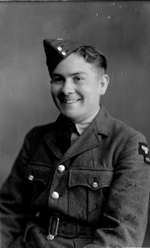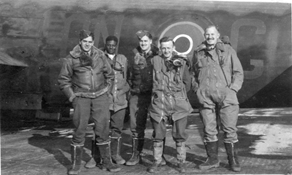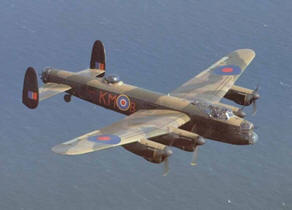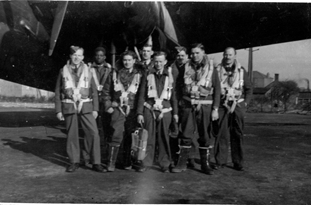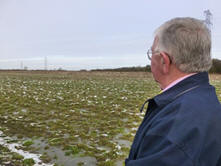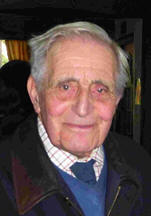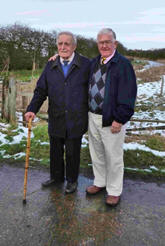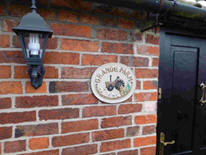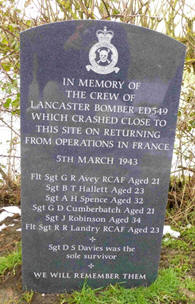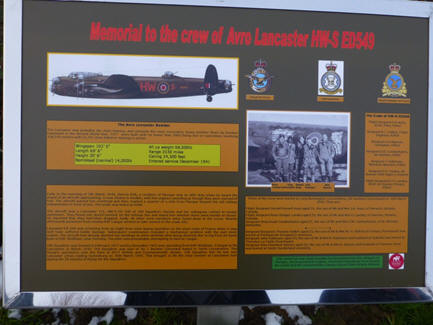Click here to go back to the main website
|
Flight Sergeant Douglas Davies, RAFVR
Sergeant Gunner 100 Squadron I have always felt that by writing and sharing one's experiences it gives the reader the opportunity to join you in your trials and tribulations, successes and happy and sometimes sad moments. Which is why I wrote a short article about my father’s dreadful experience during the second world war as an air gunner on a Lancaster bomber. On returning from a mission, the plane he was on crashed – he was the only survivor. Admittedly the article was not 100 per cent accurate as most of the information came from my mother because my father refused, point blank, to discuss what must have been the most frightening time of his life. The short article I shared with others by putting it on the family website and thought no more of it. |
|||
|
Sgt Doug Davies on joining RAFVR - 1940
|
That was until November 2012 when I received an email from a gentleman called Colin who was writing a book about air gunners during the war. He was trawling the web looking for useful information to use in his book and came across my short article. The email was to ask for further information but, as I have already explained, I had very little to go on and anyone who might have been able to help were now long gone. He agreed that I had given him little to go on and we left it at that. But, as you can imagine, my interest had been re-awakened and it was not long before I started a web trawl myself. With little to go on, it proved difficult at first until, after a very busy two days a picture appeared on my computer screen which I recognised. It was then a case of up into the attic and a mega-rummage through hundreds of old family photos stretching back many years. It didn't take long before the same photo emerged as the one that was on the computer screen - a group photo of five crew members standing in front of a Wellington Bomber. Admittedly my father was not in the picture but why should I have a copy of the same photo which had appeared on my computer screen? |
||
|
More web searching ensued and it wasn't long before the computer picture linked to a newspaper article dated September 2012. The well written article in a Leicestershire paper described a memorial service which had been held in September 2012 commemorating six Lancaster crew members who had died in a crash near the village of Plungar when it was trying to land at RAF Langar Airfield, It named the six crew members as Sgt, G R Avey RCAF Pilot, Sgt B T Hallett RAFVR Flight Engineer, Sgt A F Spence RAFVR Navigator, Sgt G D Cumberbach Barbadian Volunteer Air Bomber, Sgt J Robinson RAFVR Wireless Operator, Sgt R R Landry RCAF Rear Gunner. The article also named the sole survivor as Sgt D S Davies RAFVR Mid Upper Gunner - my father!! Now, having something to go on, I found other newspaper articles describing the memorial service attended by many villagers including the ARP warden who found the crashed Lancaster bomber and who found my father staggering along a railway line with severe head injuries, A granite memorial stone had been erected near the crash site with the names of those who had died and my father. There was also a flypast by a Lancaster bomber and two Spitfires. Also present at the service were families of the two Canadian and one Barbadian crew members. But if was sad to see that they had been unable to contact any family members of the four British crew members - including me! |
Five of the crew
standing in front of a Wellington Bomber |
||
|
A Lancaster
Bomber. My Dad was in |
It didn't take long for me to get in touch with the man who
had been the instigator of the
memorial proceedings and it was indeed
a very emotional first telephone call when I
introduced myself This was the first of many calls:
emails and much web exploring with
other organisers,
relatives of the men who were killed and newspaper reporters. The
file I started soon filled up
with many pages, including one of the extensive and comprehensive
memorial booklet.
So, what exactly happened on that fateful night of March 1943, My father had joined the Royal Air Force Volunteer Reserve in 1940 and, because he was a qualified electrician, that was where his skills were made use of. But, by 1942 he felt that he should be more involved in active duty and volunteered for bomber crew duties. Many months of intensive training turned him into an air gunner with experience on many aeroplanes including Wellington and Lancaster Bombers, In February 1943, Dad and the six other crew members who he had trained with for nearly a year were posted to RAF Waltharn (Grirnsby), a satellite aerodrome of RAF Binbrook in Lincolnshire - they were part of the newly reformed 100 squadron (originally formed in 1917), |
||
|
Thursday 4th March 1943 at 18,30 hrs, eight Lancasters took off on what was called a 'gardening mission' to lay mines in front of the submarine pens at Gironde in France. My Father was the mid-upper gunner on Lancaster 111 ED 549. One aircraft was never heard from after it took off and was presumed lost over the sea. The other aircraft returned to a completely fog bound Lincolnshire and were diverted from their home airfield to other landing sites which were hoped would be less fogbound. Unfortunately for ED549 the airfields it was diverted to were also fog bound and it was trying to land at third choice, RAF Langar in Leicestershire when it crashed, at 03.08 hrs on 5th March 1942, just a few hundred yards from the village of Plunger. The official record reads : The Squadron detailed to take part in its first operation, (mining trip) today. The briefing was attended by Group Captain Edwards, V.C.. D.S.O., D.F.C., and a number of visitors from Headquarters, No. 1 Group Captain Constantine S.A.S.O., S/Ldr. Undo (Group Nav. Officer) F/Lt. Weatherby. (R.D.F.) Eight aircraft took off, five successfully laid mines, and one bringing mines back, being unable to obtain a definite pin-point. One aircraft crashed at Plungar, Notts on return, all members of the crew being killed with the exception of Sgt Davies A/G. The remaining aircraft (F/Lt. Curie - Capt.) failed to return, no news being heard from it after take off. The Squadron was rather unlucky to two good crews on its first operational flight.
|
The ill fated
crew. The only survivor was may Dad, |
||
|
Dennis Kirk, who was the on duty ARP warden, heard the Aircraft flying low overhead. He said that it sounded as if it was short of fuel because of the stuttering engines: the next thing was that it had crashed close by. Mr Kirk is adamant that there no fire which adds to the suspicion that the aircraft was short of fuel trying to find an aerodrome that not fog bound. There are also reports that there was battle damage on the aircraft and that one of the engines was in trouble but the actual reason for the crash will never be known. Mr Kirk found that there only one survivor, my father, staggering along a railway line alongside the crashed aircraft with severe head injuries. All the other crew members had died in the crash. This is all history, but history which, until now, I knew nothing about. It is sad that my brother and sister and I missed the memorial service but a joy that we have found out about it at this late stage. There is little doubt that we will be visiting the village of Plungar in Leicestershire before very long and meeting with Dennis Kirk, the ARP Warden who found my father and the other organisers of the memorial. And my next web trawling exercise? To try and find the relatives of the three other British crew members who died in the crash so they can share with us the emotions and pride which we have felt.
Barrie
Davies
|
|||
|
|
And here is my account of the visit to Plungar
Lancaster ED549 of
100 Squadron RAF
Flight Sergeant GR
Avey – RCAF – Pilot – Killed
|
|
|
|
On a cold January day, Isobel and I made our first visit to Plungar in Leicestershire; Plungar, the village near which my father, Sergeant DS Davies, was the only survivor of a Lancaster bomber crash on 5th March 1943. But before I go into our visit, perhaps a little history will put it all into perspective. Lancaster bomber ED549 took off from RAF Waltham, Grimsby, along with 3 other planes, at 18.00 hrs on 4th March 1943. The crew were 2 Canadians, 1 Barbadian and 4 British sergeants. Their mission was to lay mines in front of the German submarine pens at St Nazaire, France. After successfully laying the mines came the 550 mile flight back to base. Unfortunately RAF Waltham, along with many other airfields in Lincolnshire and Leicestershire, had become fog bound overnight. After a number of diversions ED549 was instructed to land at RAF Langar, just 1 mile from the village of Plungar. Unfortunately, at 03.20hrs on 5th March 1943, the bomber crash landed just a few hundred yards from the airfield; all crew members except my father Sgt DS Davies perished in the crash. In 2003, probably brought to the surface by ploughing the field, a piece of metal was found at the crash scene. The man who found it put it in his shed and forgot about it. That was until 90 year old Dennis Kirk heard about it, asked to see it and, suspecting that it was part of the crashed Lancaster, gave his account of what happened on that fateful night in 1943.
|
|||
|
|
Dennis was on ARP duty that night when he heard a heavy bomber passing close overhead. The engines sounded as if they were struggling and suddenly they all cut out. This was followed by the sound of the aircraft hitting the ground. Dennis and another warden ran to the crash site where they found one airman staggering along a railway embankment, the dead rear gunner was still in his gun turret and 3 other bodies were lying close to the front of the crashed Lancaster. The sole survivor was my father Sgt DS Davies. |
||
|
In 2005, the story touched the hearts of many of the villagers of Plungar and it was not long before they took up the wishes of, now 93 year old Dennis, that the crew should be honoured in some way. After much effort and fundraising, and after making tremendous efforts to find surviving relatives of the Lancaster crew, in September 2012 a memorial service was held at Plungar church. Family representatives of the Canadian and Barbadian crew members, an official from the Barbadian High commission, Royal Air Force and Royal Canadian Air Force officers in attendance, a packed church conducted a truly magnificent memorial service in memory of the crew of Lancaster bomber ED549. The service was followed by a flypast by a Lancaster and two spitfires. A memorial stone was dedicated and now stands proud at the site of the crash. |
|
||
|
|
Unfortunately, and despite a huge effort, the villagers of Plungar were unable to find relatives of any of the four British crew members. That was until November 2012 when, by pure chance, I found on a website a photograph that I recognised; it was of 5 crew members standing in front of a Wellington Bomber. Into the old photo albums in the attic I went and there it was – my copy of the very same photograph. It did not take long for me to find that the photo was part of an article in a Leicestershire newspaper describing the memorial service held some 2 months before in which my father’s name Sgt DS Davies, appeared. The next few weeks were an emotional frenzy of telephone calls and emails between myself, memorial organisers and relatives of the Canadian and Barbadian crew members. The end result was our visit to Plungar – and so we come back to the beginning of this story.
|
||
|
The day started with a visit to the home of David and Ann Webb, two stalwarts of the memorial committee who filled us in on many bits of the story surrounding ED549 – which he strongly pointed out was ‘our Lancaster’. Then on to the village pub, the Anchor, where we met with many of the memorial committee including Tim Chamberlin who, as a military historian, was able to explain many of the facts surrounding the crash. Perhaps the most emotional point was when Dennis Kirk arrived and it was our first opportunity to meet the man who found my father at the crash site some 70 years before. Dennis, with an incredible memory, was able to tell us exactly what happened on that fateful night and his thoughts as to why it had happened. Then it was on to the crash site where Dennis explained where the Lancaster had hit the ground, where the bodies and my father were found, what he thought had happened and he strongly stressed that there was no fire involved in the crash. The memorial and information display were situated alongside the canal and railway embankment close to the site of the crash. Dennis explained that after my father had been found he was taken to a local farmhouse until the rescue teams from RAF Langar arrived. The day ended up in Dennis’s home where his wife, a superb cook, provided us with a tea that surpassed anything a five star hotel could provide. After bidding an emotional farewell, Isobel and I started the long journey back to Maidenhead. Indeed a very memorable day.
|
|
||
|
|
So, what exactly happened to ED549? Lots of research has gone into the tragedy particularly by Tim Chamberlin and Bob Cumberbatch. It seems that when sent on missions such as this, the bombers were given the bare minimum of fuel with a small reserve to cover eventualities. ED549 was in the air much longer that the other aircraft on the mine laying expedition which may possibly be explained by a number of attempts to lay the mines in the correct location. Similarly a lot of fuel may have been used up by diversions around home airfields looking for one that was not fog bound. Whatever, Denis Kirk’s account points to the fact that the engines were stuttering and that they cut out just before the crash which indicates that ED549 ran out of fuel just 400 yards short of Langar airfield. The point where the bomber hit the ground was unfortunate in itself. Between the point of impact and Langar airfield is just open, flat countryside where a ‘pancake’ landing with no fatalities would have been easy. Unfortunately the plane hit the ground right on top of a 15 foot railway embankment, the only raised point for miles around. Theory and thinking indicate that when it hit the embankment the plane snapped in half; the rear section with the rear gunner still inside was found one side of the embankment and the front section with five other crew members was in the field on the other side of the embankment. The point where the fuselage broke in half would have been where my father was situated – in the mid upper gun turret – which would explain how he would have been thrown out and why he was found staggering along the top of the railway embankment.
|
||
|
If ED549 had managed to fly another 30 yards, in all probability it would have missed the embankment and ‘pancaked’ in the field. If the plane had been loaded with another 5 gallons of fuel, it could probably have managed to make it to Langar Airfield. There could be many ifs and buts. As Tim Chamberlin pointed out, all the crew were in their normal flight positions and that if a crash landing was expected they would either have been told to bale out or adopt a crash position behind the main spar of the airplane. In other words, a crash landing was not expected by the pilot or crew. What the villagers of Plungar have done and organised in memory of ‘our Lancaster’ and its crew members is a magnificent effort and one for which I will be eternally grateful. They have enabled me to see and think about something which my father refused to discuss with his children Plungar – Thank you!!
Barrie
Davies
|
The Information board at the crash site |
||
